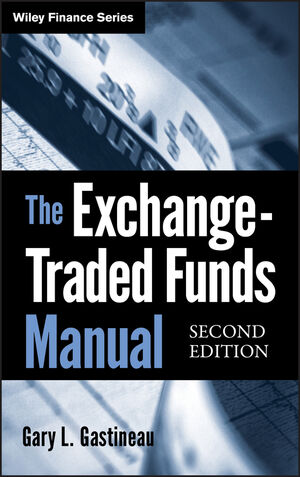The Exchange-Traded Funds Manual, 2nd EditionISBN: 978-0-470-48233-9
Hardcover
384 pages
July 2010
 This is a Print-on-Demand title. It will be printed specifically to fill your order. Please allow an additional 10-15 days delivery time. The book is not returnable.
|
||||||
Preface ix
Acknowledgments xi
Chapter 1 An Introduction to Exchange-Traded Funds 1
Exchange-Traded Funds Were Introduced as “Something to Trade” 1
Shareholder Protection 3
Tax Efficiency 7
Cost Transparency is Desirable, But Trading Transparency is Costly 9
Intraday ETF Trading 10
Comparing ETF and Mutual Fund Economics 11
Conclusion 17
Chapter 2 The History and Structure of Exchange-Traded Funds—and Some of Their Competitors 19
Some Major Financial Market Developments (1975 to 2000) 19
Declining Trading Costs Increase Financial Engineering Opportunities, and Financial Engineering Reduces Trading Costs in the New Millennium 23
A Brief History of ETFs 25
Other Tradable Basket Products 34
Chapter 3 The Regulatory Framework and Mechanics of the Open-End ETF 43
U.S. Fund Regulation Has Played a Major Role in the Structure of ETFs Introduced around the World 43
The Investment Company Act of 1940 45
Exemptions from the Investment Company Act of 1940
Have Been Granted to Permit Issuance of Open-End ETFs 47
ETF Developments Outside North America 50
Proposed Rule 33-8901 and Limitations on ETF
Trading Transparency 53
The Mechanics of ETF Creation and Redemption In-Kind 53
Chapter 4 Taxation of ETFs and Their Shareholders 65
Taxation of Investment Companies: Subchapter M and Regulated Investment Company (RIC) Requirements 65
The Mechanics of RIC Shareholder Capital Gains Taxation 73
The Wash Sale Rule 81
Other Pass-Through Collective Investment Vehicles 82
The Relative Tax-Efficiency of Mutual Funds, Exchange-Traded Funds, and Portfolio Baskets 90
Deferral of Long-Term Capital Gains 93
Outlook for Changes in Investment Company Taxation 98
Chapter 5 The Economics of Indexing, Trading Transparency, and Limited-Function Active Management of ETFs 101
Indexing Works Best When Approached with Common Sense 102
The Continuum: From Passive to Active 108
Benefits from a Decline in ETF Trading Transparency 110
How Trading Plans Become Transparent 112
Effect of Transparency Costs on Fund Performance 121
Silent (Nontransparent) Indexes 124
A Battle of Contrasting Index Fund Management Strategies 126
Chapter 6 Fund Ratings and Rankings—The Evaluation and Selection of ETFs and Mutual Funds 131
An Introduction to Fund Ratings 131
Wanted: A Comprehensive But Eclectic Approach to Fund Evaluation and Analysis 140
Measuring and Comparing Fund Performance 141
A Perspective on the Limitations of Fund Analysis Today 142
Elementary Fund Economics 146
The Largest Cost for Most Funds is Not Reported to the Fund’s Investors 149
What is Tracking Error? 155
Net Tracking Error as a Framework for Fund Performance Evaluation 161
Positive (Value-Added) Elements 168
eXtensible Business Reporting Language (XBRL): The New Data Standard 170
There is a Wide Range in the Quality of Fund Touts, Tools, and Techniques 172
Fund Governance 179
Chapter 7 How Will Full-Function Actively Managed ETFs Work? 183
The SEC Concept Release and Limited-Function Actively Managed ETFs 183
Chapter 8 How to Minimize Your Cost of Trading ETFs 197
ETF Trading is Different from Stock Trading 197
ETF Intraday Net Asset Value (NAV) Proxies 200
The Brave New World of High-Frequency Electronic Trading 202
ETF Trading Volume is Huge, Growing, and Highly Concentrated 207
How to Trade ETFs Efficiently 208
Market-on-Close (MOC) Transactions in ETFs 210
Introducing NAV–Based Trading in Exchange-Traded Funds 218
Conclusion 224
Chapter 9 Economics and Market Effects of ETF Short Selling 227
Understanding the Risks of Selling ETFs Short 227
The Implications of ETF Short Selling 231
ETF Short Selling for Traditional Investors 234
Chapter 10 Leveraged Long and Inverse Exchange-Traded Funds 245
Trading Sardines 245
How Leveraged Long and Leveraged Inverse ETFs Construct Their Portfolios 246
Is It Useful to Describe Leveraged Fund Returns as Path Dependent? 254
Leveraged Fund Return Patterns 255
Taxation and Distributions from Leveraged ETFs 259
Other Issues Affecting Leveraged ETFs 260
Another Way to Obtain Leverage Without Borrowing 261
The Bottom Line on Leveraged ETFs 262
Chapter 11 ETF Applications for Individual Investors and the Advisors Who Serve Them 263
Short-Term ETF Trading Sometimes Makes Sense 265
ETFs as Portfolios and as Components 266
Integrating Diverse Family Accounts 267
Tax Management 268
Other Tax Issues 270
Thinking Outside the Box 274
Measuring the Comparative Economics of Trading and Holding Different Components of an Index Arbitrage Complex 275
Chapter 12 ETFs for Investors Living Outside the United States 279
Some Features of the ETFs Described in This Book Are Not Universal 279
Chapter 13 A Few Things Everyone Should Know about Investment Returns and Retirement 285
Chapter 14 Where to Look for Help in Using ETFs 293
Sources of Professional Help 293
The Advisory Relationship 296
Sources of ETF Information 298
Bibliography 303
Glossary 313
About the Author 351
Index 353



